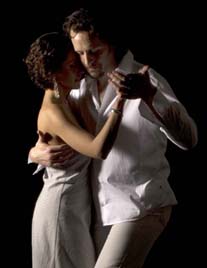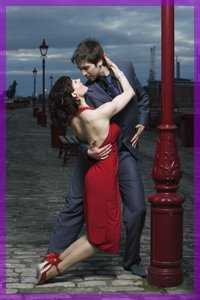Tango in Torquay... Two: the Classes
19th January 2011
Tango In Torquay One | Tango In Torquay Two | Tango In Torquay Three | Tango In Torquay Four
- Introduction
- Class: Musicality (intermediates)
- Class: Decorations and Pivots (advanced)
- Class: Free leg play (advanced)
- Overall thoughts
Introduction
So, as described in the previous entry, I went to the Rockbottoms Tango weekender in Devon, from 14-17th January.
This entry is about the classes - basically, my notes and thoughts from the classes I took.
I had intended to do a few classes on Saturday, then a few on Sunday. In the event, I achieved a grand total of zero classes on Saturday, but I managed to get to three classes on the Sunday.
Classes were held in two separate rooms, and lasted an hour each. Considering the relatively small scale of the weekender, there were a lot of classes - around 30 in all - and the classes all seemed well-attended.
Class levels
The classes were classed into three levels:
- Beginner (up to 1 year)
- Intermediate (1 - 2.5 years)
- Advanced ("good").
Levels of classes are always problematic things - just because someone's been dancing two years doesn't mean they're better than someone who's only been dancing two months. But it's best to have some levels defined, to give some structure, than to have none at all.
I did one Intermediate class and two Advanced classes.
Class: Musicality (intermediates)
Sunday, 11.10am - 12.10pm.
Teachers: Rene and Hiba

The first half of this lesson was about musical interpretation, the second half was using musicality within the context of a taught sequence.
Interpretation exercises
We did several interpretation exercises:
- Leader choosing to dance to specific instruments; follower had to guess the instrument the leader was dancing to. If the follower guessed correctly, the leader then switched instruments and repeated.
- Leader not dancing to the beat - that is, dancing to anything else other than the double bass providing the main beat.
- Leader dancing only to the beat, and the follower tapping on the "and" (that is, between the beats)
Pattern: "stretcher"
We then worked on a "stretcher" pattern - without going in to too much detail, this basically involves a 180-degree turn, split into two movements which were in some ways similar to a cross-body lead.
We then introduced some musicality into these movements, using rebounds and double-timing within the pattern.
What did you think?
The musical exercises are very interesting, but it may have been a bit optimistic to expect most of the attendees to be able to dance clearly to the different instruments in a track - it might be better to have either explained and demonstrated this a little first, or to put that exercise in an "advanced" class.
The stretcher pattern was also very interesting; I'll definitely work on practicing that one. The problem I had with it initially was that I seemed to lead it like a giro, rather than as two separate "elongated" movements. Once I split them up in my mind, I could then lead each one distinctly.
So I got two solid benefits out of the class - a new movement and a new tool to work with.
Rene and Hiba work very well together; like all classes it was well-attnded but they managed it well and also managed to give individual assistance. I'm now more motivated to attend their regular classes at the Dome.
Class: Decorations and Pivots (advanced)
Sunday, 12.20pm - 1.20pm
Teachers: Amir Giles and Monica

The structure of this class was in some ways similar to the previous one with Rene and Hiba; the first half of the class was about exercises, and the second introduced a pattern to practice the techniques developed in the exercises.
Musicality exercises
This is a lovely track; it's all about a lovely area in Argentina called Cordoba. It's very light and cheerful, not at all like a usual "You left me and you stole my car, you bitch" tango track. So, there's no need for a standard Tango Sour Face when you're dancing to this one." ~ Amir
We did several musicality exercises:
- Walking in time (side by side) with partners, one keeping the beat, the other decorating - swapping roles and directions.
- The same, but swapping roles
- The same, but backwards
- (Individually) a forward-forward-side pattern, then decorating the sidestep part of the pattern.
Pattern: pasadas and "orbits"
"Followers, you can be like honey" - Monica
We did some work with pasadas: basicallly leading a series of pasadas, and the follower deciding how to embellish each one. The follower could decide to resist ("being like honey") to extend the movement, and can lower herself down to draw a wider circle with the pivot. Note: if the follower lowers herself, the leader should also lower himself.
We then finished off doing "orbits" - basically, both partners walking in a circle around a central point. This can be done in either direction, and either partner can be on the inside / outside.
Once we got the hang of this, the followers could then change their footwork during the orbit, as per the first exercise (but now in hold).
What did you think?
(Note: the other couples are two-teacher partnerships; in this case, Monica was more of a demonstrator than a teacher - and I mean that in a good way. Monica's a goregous dancer, she works very well with Amir, and when she did speak she definitely clarified things, but Amir was the one doing most of the talking.)
For me, this class was less interesting. I don't know why, and this is definitely not a criticism of the class; Amir's a great teacher, Monica's a great helper, and the material was also good.
But I think it's because the general topic had a lot of overlaps with the Musicality class I'd just done, so the material seemed quite familiar. It's also likely that I just can't process two classes, one immediately after the other, so I should probably allow a gap between each class.
One of the main benefits I got from this one was a reminder to work on pasadas. I may try orbits as well, but they seem to require a lot of space to do, so I'm not sure how useful they are in general in social dancing.
Class: Free leg play (advanced)
Sunday, 5pm - 6pm
Teachers: Jenny and Ricardo

We started by doing a sequence of barridas in a line - walking to the side of the follower, doing a drag-and-step sequence with the leader's right leg (and follower's right leg).
We then spent some time extending this barrida into a sandwich-then-side-colgada-then-gancho sequence, with the woman's left leg coming out and around the man's left leg.
A couple of technique tips
- Colgadas have to be led (and followed) with confidence - it's much easier to lead them with some "oomph" than to try and to them "safely".
- With a gancho, the hook part should only happen after the follower's leg makes contact with the leader's leg. That way, no-one gets kicked.
What did you think?
Jenny and Ricardo are both excellent teachers. They've earned their reputation at the top of the TangoTeacherTree. They interact brilliantly with each other, they keep the class interested and amused, and they manage to also impart a consistent message. There's no disconnect between their separate messages - they say the same thing, but they manage to say it in totally different ways, so doubling the chances of the information getting retained.
(If I had to provide a critique, I also think the title was possibly slightly misnamed - I'd say it was a "Colgadas and Ganchos" class as much as a "free leg play" class.)
The class itself was actually relatively straightforward, but the time flew by. It was a great way to finish the classes for the weekend.
Overall thoughts
The teaching line-up was first-rate. All three couples are great teachers, with a lot of experience and ability. It's a real pleasure to encounter the dilemna of whether to do a class with Amir and Monica, or with Jenny and Ricardo.
(Note: I've not included any reviews of Keith and Bev (the Modern Jive teachers), as I didn't attend any of their classes. But I'm sure they're equally-talented.)
Considering the numbers (c.200 attendees), the numbers of attendees at classes was high - each class I attended had 40+ students. So I think the people at the weekender were very keen to learn, and it certainly validates the choice of teachers.
There's something about a weekender that, for me, makes it easier to retain information from classes - I think it's the atmosphere of dance and the lack of distractions. But certainly, I got more out of the three classes I did than I would have anywhere else.
Coming next
In my next entry, I'll review the evening milongas.
~ David Bailey, 19th January 2011